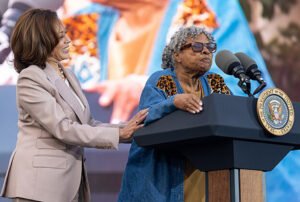
How can community groups shift narratives? A ballot initiative campaign from 2020 provides some important lessons. That year, community organizing groups and labor unions across California launched a campaign to take on the corporate loophole in Proposition 13 and reclaim billions of dollars for public schools and public services.
They knew they faced an uphill battle. Proposition 13, or Prop 13—the 1978 ballot initiative that capped property taxes in the state and set the stage for the presidency of Ronald Reagan two years later—has long been described as the “third rail” of California politics.
A Los Angeles Times columnist wrote as late as 2019 that Prop 13 “may be practically untouchable,” with even otherwise progressive Democrats unwilling to go near it for fear of losing homeowning voters come election season. A 2018 study demonstrated its continued broad support, even though the tax limitation measure decimated funding for the state’s public schools. This decimation is not just rhetorical: a documentary of California public schools that aired on public television in the early 2000s was titled From First to Worst.
Even so, according to the 2018 study, two thirds of all likely voters in the state, including 55 percent of Democratic voters, continued to believe that Prop 13 had “turned out to be a good thing.” Those numbers match up almost exactly with the measure’s margin of victory in 1978, pointing to the proposition’s enduring appeal, even as the state’s electorate has become more racially diverse and as California has shifted politically from a state that regularly elected Republicans to statewide office, to one that routinely elects Democratic supermajorities—for example, presently more than 75 percent of state legislators are Democrats.
Yet in 2020, an unprecedented coalition led by community and labor groups came close to passing Proposition 15, a ballot initiative that would have ended Prop 13’s commercial property tax loophole—the “biggest change to California property taxes” since Prop 13 itself. The Yes on 15 coalition was able to get 48 percent of Californians to vote in favor of the ballot measure, which would have brought in an estimated additional $12 billion annually to fund local schools and communities. This all occurred during an election that saw increased turnout among white and more affluent voters who lean Republican, the so-called “Trump bump.”
For Sabrina Smith, CEO of one of the campaign’s anchor organizations, California Calls, the vote’s narrow margin is evidence that the “third rail” of California politics has been severely weakened. Out of 18 million votes cast throughout the state, a mere 670,000 votes made the difference. “We stretched the imagination of what’s possible,” Smith says.
The Yes on 15 coalition knew that in addition to mobilizing millions of voters, it had to fight on the terrain of narrative and build a campaign that would challenge and shift the underlying beliefs that have given Prop 13 its resonance. As Smith told us, Prop 13 has “poisoned people’s perception of the role of government in our lives,” creating narrative challenges that the campaign would have to tackle head-on.
Many might conclude that because Proposition 15 fell short, the campaign failed to significantly impact the narrative. But we have a different view. Shifting narrative is never about one campaign. As practitioners of narrative change in the service of social transformation, we have a lot to learn from both the successes and challenges of the Proposition 15 campaign regarding how to build long-term narrative power for our movements—and, in so doing, how to build economic and political power.
Narrative Change is a Long-Term Process
Understandably, election campaigns focus on the short-term. But narrative change is a long-term project. Building narrative power for our movements requires a healthy ecosystem that combines leadership development, relevant tools and technology, substantial and sustained financial resources, and containers for collaboration and coordination. Our opposition has had decades to build their organizing and narrative infrastructure; our strategy needs to be similarly long-term and similarly wide-ranging.
California Calls launched in 2009 as a statewide alliance of grassroots organizing groups. At the time, Prop 13 was already in the organization’s sights because, as Smith explains, “all roads lead back to the crisis in raising the revenue to fund what our communities need.”
An early win came in 2012 with a successful ballot initiative campaign to pass Proposition 30, which raised the income tax rate of California’s wealthiest residents to fund schools and other social services. “One of the consequences of that victory was disrupting the belief that [a campaign to raise] taxes couldn’t be successful statewide,” Smith explains. Campaigns to pass Proposition 30 and other stepping-stone campaigns not only built a larger and more engaged voter base; they also took advantage of election cycles to foreground a different understanding of taxes and the role of government in our lives. They laid the groundwork to challenge old narratives and planted seeds for new ones, setting the coalition up to, as Smith puts it, “take on the biggest structural fight that we’ve engaged in so far”—Proposition 15.
In other words, shifting narratives requires not only a robust suite of communication and cultural tools and tactics but also strong organizing—and a multi-year, if not multi-decade, vision.
Yet a challenge we’ve observed is that social justice organizations and movements lack the narrative infrastructure they need. This has hampered movements’ collective ability to take on big fights and win. This shortcoming must be addressed.
Building the Next Generation of Leaders
To build narrative power, the two organizations from which we hail—ReFrame and Power California—ran an experiment to support youth organizations engaged in the Yes on 15 campaign and to seed infrastructure for continued narrative power building. In 2019, our two groups launched the Gen Now fellowship to strengthen youth collective narrative capacity, align strategies across organizations, and lay the foundation for a robust community-centered narrative ecosystem—for both near- and long-term policy change.
In 2020, as part of the Gen Now fellowship, we worked with leaders from Power California alliance partners, like InnerCity Struggle (ICS), to advance a strategy focused on changing young people’s conception of taxes and government through robust communications and cultural tactics intended to educate young voters on Proposition 15. “Our narrative strategy with young people was to show schools as a beacon of hope and that equitable funding would make that type of school possible,” details Esthef Solano, now the group’s communications director. “In our communities, young people and their parents advanced the narrative that our coalition landed on as they told their stories in various places, like in public testimonies, interviews with reporters, and on social media.”
This work was rooted in our core belief that when narrative strategy is integrated into organizing, impacted communities can expand their notions of what is possible. Larger narratives, in dynamic relationships with individual stories, help people see their personal experiences as part of a larger arc, inspiring collective action and building power toward social change.
Sign up for our free newsletters
Subscribe to NPQ's newsletters to have our top stories delivered directly to your inbox.
By signing up, you agree to our privacy policy and terms of use, and to receive messages from NPQ and our partners.
Challenging Dominant Counter-Narratives
As the Yes on 15 coalition prepared to launch, it knew that it would need to overcome the dominant, “common sense” narratives about the role of government that the Right and corporate interests have reinforced for decades—negative beliefs that have led many to doubt government’s ability to improve people’s lives. People have contradictory attitudes and beliefs: they want more funding for their schools, but they doubt funding will ever arrive in their neighborhoods. “People want nice things and good services, but don’t believe that government is going to be able to deliver them efficiently. Part of what we were experimenting with was, how do we reframe government and really connect it to people’s everyday lives?” Smith explains.
There was another dominant narrative at play—the belief that corporations represent “the economy” and are job creators and that government is a “job killer.” While many recognize that corporations don’t pay their fair share, Smith notes that “there’s also faith in big business, and a fear that taxing businesses is going to drive out jobs or drive up the cost of living.”
The opposition to Proposition 15, led by some of the state’s largest real estate corporations and businesses, leaned heavily on those narratives, exploiting fears that small businesses—especially those owned by people of color and immigrants—and job growth would be hurt if Proposition 15 passed.
At times, the opposition put out disinformation, including a categorically false claim that Prop 15 would raise taxes on homeowners. The COVID-19 pandemic, which increased economic anxiety as businesses shuttered and people lost their jobs, only gave those stories more power. One television ad by the opposition, which featured a Black barbershop owner posting a “Going Out of Business” sign on his front door, was particularly compelling; as is too often the case with well-funded corporate campaign blitzes, such advertising wiped out what had been favorable polling data. As Smith puts it, despite representing some of the state’s most powerful corporate interests, anti-Prop 15 campaigners “positioned small business owners and people of color as the face of the opposition.”
One key lesson, albeit not a new one, is this: stories with emotional resonance profoundly shape people’s sense of how the world works and their place in it. Stories bring salient and emotionally compelling details to deeper narratives. Narratives imbue stories with deeper and unified meaning. Combined, they help people make sense of their experiences, shaping what they believe and how they should behave.
The Yes on 15 campaign tried to balance the need to educate the broader public that the corporate loophole even existed and the need for more impact storytelling in the service of narrative change—real people telling moving stories and backed up by the resources necessary to push these stories out at scale.
This impact storytelling occurred during the campaign, often led by community organizations like ICS and people like Esthef Solano, who along with other Gen Now fellows located in communities throughout the state, used the skills they learned through the fellowship to launch a coordinated, youth-driven media strategy in support of the ballot measure. In the months leading up to the November election, participants got the voices and stories of young people and students placed in local media outlets, through press events, media coverage of their work, letters to editors, and op-eds.
This type of storytelling also happened in other communities. Coalition partners in the Million Voters Project deployed digital and print media strategies in Spanish and nine Asian languages, centering culturally specific stories and trusted messengers.
But these stories were not pushed out at the necessary scale, nor was this type of storytelling at the center of campaign strategy. Imagine the airwaves filled with real people telling stories of their schools, their communities, their lives. Might such an approach have enabled the Yes on 15 campaign to pass? Given the slim margin of defeat, we believe so.
Building Movement Narrative Infrastructure for the Long Haul
Funding for civic engagement work typically tracks with election cycles, with resources drying up in off years then ramping back up whenever there’s an election, increasing as election day approaches.
But the work of building narrative power and shifting underlying beliefs doesn’t just happen during election cycles, and it certainly doesn’t just happen in the last days of election season—it is a cumulative, dynamic process. It is often in acute moments, like the Yes on 15 campaign, that narrative seeds planted and cultivated over years bear fruit.
Even when we look to one campaign’s life cycle, we see that resourcing is often all wrong when it comes to progressive issues. According to Smith, “Not having the resources early enough impacted our ability to get out early to frame the campaign and water the narrative seeds we planted in previous campaigns.” She added, “Most voters didn’t know about Prop 13 and the loophole, and there was a large segment of voters that were soft yeses. We knew we needed to get our message out first but couldn’t pull the trigger for fear of running out of resources at the end.”
Beyond the resources needed to successfully mount a narrative strategy during a time-limited campaign, there is a need for funders and donors to invest heavily in both organizing and narrative-change strategies for the long haul. As Smith puts it, “We need to build and expand the bench of organizers and communicators.” Smith notes that during the Yes on 15 campaign, the coalition was hampered by a lack of regional coalitions that could have “organized broader sets of groups and constituencies to engage in activities in the campaign” and pushed out tailored stories.
This speaks to a broader need for investment in organizing infrastructure as well as narrative-change capacity. Skilling up one organization, or one community, does not directly lead to narrative change. But when we skill up networks of people who are already in relationship with one another and who already have a foundation of trust and are in strategic alignment, it is possible to scale up and deepen impact. This evidently requires, not just fellowship projects, but a comprehensive approach.
While the Yes on 15 coalition may have narrowly lost the policy battle, Smith believes their work has shifted the landscape—the “third rail” of California politics, which originally passed with the support of two thirds of state voters, barely avoided radical reform. What was once considered untouchable is now seen as vulnerable. And she pointed to the multi-sector coalition built to pass Proposition 15, as well as the base of voters, volunteers, and endorsers who signed on to Yes on 15.
“All of those things can be leveraged for future fights,” Smith says. She adds that “big, bold, transformational change is a long-term project.”
Esthef Solano of InnerCity Struggle agrees. “Even though we lost the campaign to change this policy, our narrative will stick with folks.” Solano concedes that, “One campaign isn’t going to cure the years of historic disinvestment that our communities have faced.” Still, she believes movement groups are “getting closer to building a unified front around our shared vision for the future. There’s a bigger story we need to tell, and each campaign helps to strengthen that story.”
That the Yes on 15 campaign came so close to winning shows us what is possible—and its shortfalls show us where we need to go. Shifting long-standing narratives requires deep alignment within a progressive ecosystem, as well as the resources to both build long-term organizing and narrative infrastructure and push out stories at scale. Funders who seek immediate outcomes may not always find talk of long-term infrastructure building “sexy,” but such building is one key thing movements need to create a just and equitable society. We believe such infrastructure can be the difference between winning and barely losing. For the sake of communities most deeply impacted by racial and economic injustice, such building needs to start today.













